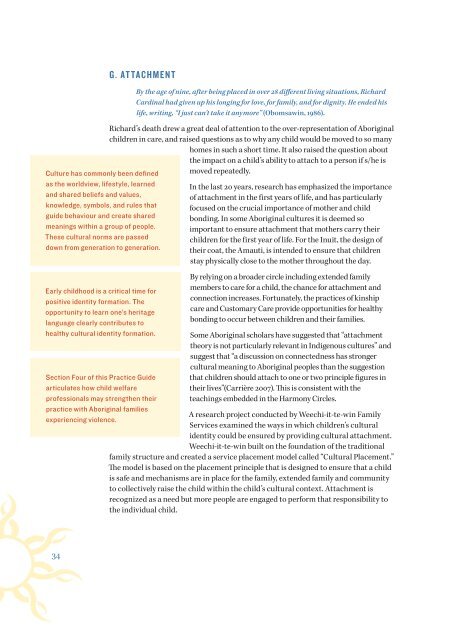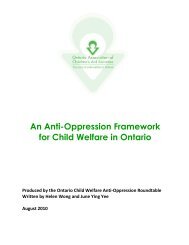English - Ontario Association of Children's Aid Societies
English - Ontario Association of Children's Aid Societies
English - Ontario Association of Children's Aid Societies
You also want an ePaper? Increase the reach of your titles
YUMPU automatically turns print PDFs into web optimized ePapers that Google loves.
G. ATTACHMENT<br />
Culture has commonly been defined<br />
as the worldview, lifestyle, learned<br />
and shared beliefs and values,<br />
knowledge, symbols, and rules that<br />
guide behaviour and create shared<br />
meanings within a group <strong>of</strong> people.<br />
These cultural norms are passed<br />
down from generation to generation.<br />
Early childhood is a critical time for<br />
positive identity formation. The<br />
opportunity to learn one’s heritage<br />
language clearly contributes to<br />
healthy cultural identity formation.<br />
Section Four <strong>of</strong> this Practice Guide<br />
articulates how child welfare<br />
pr<strong>of</strong>essionals may strengthen their<br />
practice with Aboriginal families<br />
experiencing violence.<br />
By the age <strong>of</strong> nine, after being placed in over 28 different living situations, Richard<br />
Cardinal had given up his longing for love, for family, and for dignity. He ended his<br />
life, writing, “I just can’t take it anymore” (Obomsawin, 1986).<br />
Richard’s death drew a great deal <strong>of</strong> attention to the over-representation <strong>of</strong> Aboriginal<br />
children in care, and raised questions as to why any child would be moved to so many<br />
homes in such a short time. It also raised the question about<br />
the impact on a child’s ability to attach to a person if s/he is<br />
moved repeatedly.<br />
In the last 20 years, research has emphasized the importance<br />
<strong>of</strong> attachment in the first years <strong>of</strong> life, and has particularly<br />
focused on the crucial importance <strong>of</strong> mother and child<br />
bonding. In some Aboriginal cultures it is deemed so<br />
important to ensure attachment that mothers carry their<br />
children for the first year <strong>of</strong> life. For the Inuit, the design <strong>of</strong><br />
their coat, the Amauti, is intended to ensure that children<br />
stay physically close to the mother throughout the day.<br />
By relying on a broader circle including extended family<br />
members to care for a child, the chance for attachment and<br />
connection increases. Fortunately, the practices <strong>of</strong> kinship<br />
care and Customary Care provide opportunities for healthy<br />
bonding to occur between children and their families.<br />
Some Aboriginal scholars have suggested that “attachment<br />
theory is not particularly relevant in Indigenous cultures” and<br />
suggest that “a discussion on connectedness has stronger<br />
cultural meaning to Aboriginal peoples than the suggestion<br />
that children should attach to one or two principle figures in<br />
their lives”(Carrière 2007). This is consistent with the<br />
teachings embedded in the Harmony Circles.<br />
A research project conducted by Weechi-it-te-win Family<br />
Services examined the ways in which children’s cultural<br />
identity could be ensured by providing cultural attachment.<br />
Weechi-it-te-win built on the foundation <strong>of</strong> the traditional<br />
family structure and created a service placement model called “Cultural Placement.”<br />
The model is based on the placement principle that is designed to ensure that a child<br />
is safe and mechanisms are in place for the family, extended family and community<br />
to collectively raise the child within the child’s cultural context. Attachment is<br />
recognized as a need but more people are engaged to perform that responsibility to<br />
the individual child.<br />
34

















